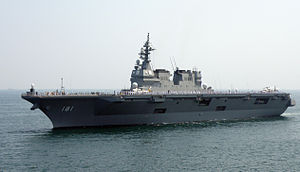Hyūga-class helicopter destroyer

Hyūga at sea in 2010
|
|
| Class overview | |
|---|---|
| Name: | Hyūga class |
| Builders: | IHI Marine United |
| Operators: |
|
| Preceded by: | Shirane class |
| Succeeded by: | Izumo class |
| Completed: | 2 |
| Active: | 2 |
| General characteristics | |
| Type: | ASW carrier |
| Displacement: |
|
| Length: | 197 m (646 ft) |
| Beam: | 33 m (108 ft) |
| Draft: | 7 m (23 ft) |
| Propulsion: |
|
| Speed: | more than 30 knots (56 km/h; 35 mph) |
| Complement: |
|
| Sensors and processing systems: |
|
| Armament: |
|
| Aircraft carried: | |
| Aviation facilities: | Flight deck and enclosed hangar |
The Hyūga-class helicopter destroyer (ひゅうが型護衛艦 Hyūga-gata-goei-kan?) is a class of helicopter carrier built for the Japan Maritime Self-Defense Force (JMSDF). Two - Hyūga and Ise - were built; upon completion the class were the largest ships built for the Japanese navy since the Second World War.Hyūga was described in a PBS documentary as the "first Japanese aircraft carrier built since WWII."
The Hyūgas were followed by the larger Izumo class, the first being commissioned in March 2015. The Izumos will replace the Shirane-class helicopter destroyers; the Hyūgas were originally meant to replace the Shiranes.
The specifications of the Hyūga class are comparable to light aircraft carriers, such as the Italian Giuseppe Garibaldi and Spanish Príncipe de Asturias. Under the JMSDF's naming conventions, the ships are called Goei-kan (護衛艦, lit. escort ship) in Japanese and destroyer in English, as same as all the other combatant ships of JMSDF.
During development, Hyūga and Ise were provisionally named "16DDH" and "18DDH" respectively. The numbers derived from the Japanese calendar, specifically the 16th year and 18th year of the Heisei reign (2004 and 2006), when the provisional name were given.
...
Wikipedia
